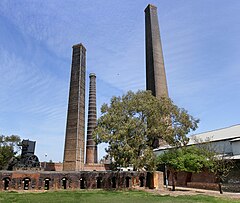Sydney Park, Sydney
| Sydney Park | |
|---|---|

Former Austral brick works at Sydney Park.
|
|
| Location | St Peters () |
| Nearest city | Sydney, New South Wales |
| Coordinates | 33°54′38″S 151°11′05″E / 33.9105284°S 151.1846209°ECoordinates: 33°54′38″S 151°11′05″E / 33.9105284°S 151.1846209°E |
| Area | 44 hectares (110 acres) |
| Created | 11 February 1991 |
| Operated by | Sydney City Council |
| Open | 24 hours |
| Status | Open all year |
| Public transit access | St Peters railway station |
Sydney Park is a large recreational area in the inner-city area of Sydney, New South Wales, Australia. The parkland is located in the suburb of St Peters, sitting along the borders of Alexandria, Newtown and Erskineville.
Sydney Park is 41.6 hectares (103 acres) in area, which makes it the third largest park in inner-city Sydney. The park comprises large open recreation spaces with distinctive hills that provide 360 degree views over Sydney, a children's playground, wetlands, a sports oval (Alan Davidson Oval), a children's bicycle track, sculptures, a heritage area featuring the remains of the brickworks that formerly occupied part of the site, and the AIDS Memorial Grove.
Part of the park and its trees are under threat from the Westconnex transport project.
Prior to British settlement, the north-western part of the present park area would have been a forest of turpentine and ironbark trees, grading down towards the south-eastern area, situated on Botany Sands, which would have been swamp, marsh and heathland associated with the waterway that became known as Shea’s Creek. The woodland area was first cleared by Thomas Smyth, a marine sergeant with the First Fleet, who planted fruit trees and grain crops.
The north-west part of the park is situated over a bed of Wianamatta shale which became a valuable source of brick-making clay. Brick manufacture on the site was a major industry by the 1870s when machine manufacture was introduced. Bricks made here were widely used around Sydney’s suburbs for more than 100 years and the first batch of machine-made bricks was used for the construction of the Farmers’ Building on the corner of Market Street, Sydney. Josiah Gentle opened the Bedford Brickworks in 1893. In 1933, it was taken over by Austral Bricks, who had a large brickworks in Cowper Street, Marrickville. They operated the site until the brickworks closed in 1970. Their Marrickville site was closed down in 1983. Other parts of the Alexandria site were used for a variety of industrial purposes including manufacturing, warehousing and gas storage. The brickworks are heritage-listed. They are also used by homeless people.
...
Wikipedia
